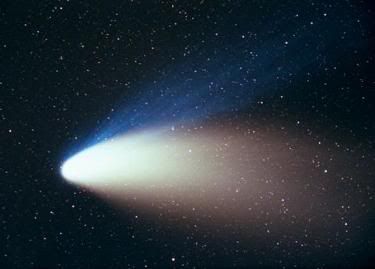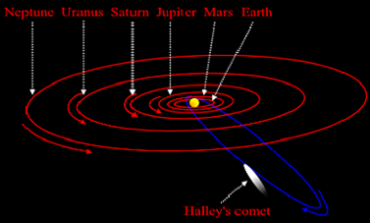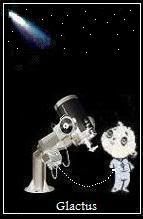Post by glactus on Oct 15, 2011 1:01:38 GMT
Think of a comet as a big, dirty, gassy snowball, formed in the ring of rocks, dust and ice that orbits the Sun beyond Pluto called the Kuiper Belt. They form when rocks, dust and ice condense, that is, join together. As a comet gets bigger and bigger, it starts to be pulled towards and around the Sun. Comets in our Solar System usually take many years to go around the Sun, from a few dozen years to many thousands of years. This is because they orbit the sun from so far away. They make long, egg-shaped orbits around the Sun instead of almost circular ones like the planets.

The comet Hale Bopp
The comets that can been seen in the sky without telescopes are unusual because they are the biggest and brightest comets of all. Most can only been seen with a telescope.

Halley's comet orbit
When comets are very far away from the Sun they are covered in a coating of icy, black rocks and dust, but as a comet approaches the Sun the ice starts to melt. This creates large amounts of water and gas that break through the coating, freeing some of the dust and rocks. Sometimes this water, gas, rocks and dust can been seen from the Earth as one or two tails streaming away from the comet. Even when only one tail can be seen, there are two, one made from the lighter gas and water, and the other from the rocks, dust and chunks of ice.

The Soho space telescope
Some spaceships, like the SOHO telescope, have seen over a thousand different comets. Most of these comets either crash into the Sun or leave the Solar System entirely because they came too close to one of the planets like Jupiter or the Earth. There are only 160 comets that can be seen by telescopes. The rest are so far away that they can't be seen.
Many Astronomers believe that Comets deliver the building blocks of life to all Planets in the Universe and are also responsoble for depositing the water of our oceans, amd all minerals on Earth, gemstones and gold.
Comets themselves are usually between a few miles and several hundred miles in size, but their tails can be several million miles long.

Halley's comet
Credits: These are non copywrite images
Text by wikipedia

The comet Hale Bopp
The comets that can been seen in the sky without telescopes are unusual because they are the biggest and brightest comets of all. Most can only been seen with a telescope.

Halley's comet orbit
When comets are very far away from the Sun they are covered in a coating of icy, black rocks and dust, but as a comet approaches the Sun the ice starts to melt. This creates large amounts of water and gas that break through the coating, freeing some of the dust and rocks. Sometimes this water, gas, rocks and dust can been seen from the Earth as one or two tails streaming away from the comet. Even when only one tail can be seen, there are two, one made from the lighter gas and water, and the other from the rocks, dust and chunks of ice.

The Soho space telescope
Some spaceships, like the SOHO telescope, have seen over a thousand different comets. Most of these comets either crash into the Sun or leave the Solar System entirely because they came too close to one of the planets like Jupiter or the Earth. There are only 160 comets that can be seen by telescopes. The rest are so far away that they can't be seen.
Many Astronomers believe that Comets deliver the building blocks of life to all Planets in the Universe and are also responsoble for depositing the water of our oceans, amd all minerals on Earth, gemstones and gold.
Comets themselves are usually between a few miles and several hundred miles in size, but their tails can be several million miles long.
Halley's comet
Credits: These are non copywrite images
Text by wikipedia


